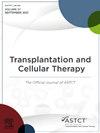骨髓纤维化的移植结果:捐献者类型[CD34+精选细胞支持的脐带血移植(Haplo-Cord)与匹配捐献者]的影响。
IF 4.4
3区 医学
Q2 HEMATOLOGY
引用次数: 0
摘要
背景:尽管异基因造血细胞移植(alloHCT)在治疗中具有潜在的治疗作用,但对于缺乏配型供体的患者来说,选择替代供体仍然是一项挑战,而且这种疾病的最佳移植来源仍然是一个持续的争论:我们的目的是评估供体类型的影响:脐带血移植支持的 CD34+ 单倍体供体(haplo-cord)与成人配型相关供体(MRD)和配型无关供体(MUD)对 40 例首次接受异体肝移植的原发性或继发性 MF(包括进展至加速期(AP)或爆发期(BP)的患者)成年患者的影响。这项研究的主要目的是分析干细胞来源对总生存期(OS)、移植物抗宿主疾病(GVHD)和非复发死亡率(NRM)等主要终点的影响:所有存活患者的中位随访时间为53个月(0.3-63个月)。九名患者(22.5%)接受了 MRD allo-HCT,15 名患者(37.5%)接受了 MUD allo-HCT,16 名患者(40%)接受了单倍体脐带 allo-HCT。四名患者在没有中性粒细胞移植的情况下死亡:3例(19%)死于单倍体脐带组,1例(4%)死于MRD/MUD组。到第 60 天,单倍体脐带组 ANC 移植的累积发生率为 80%(95%CI 45-94),MRD/MUD 组为 92%(95%CI 65-98)(P=0.09)。到第60天时,单倍体脐带组血小板移植的累积发生率为59%(95%CI 27-81),MRD/MUD组为75%(95%CI 51-88)(P=0.4)。1年的OS为62%(95%CI 49-79),3年的OS为34%(95%CI 21-55)。单倍体脐带组和 MRD/MUD 组的 3 年 OS 相似(37% vs 32%,P=0.9)。单倍体脐带组 AP/BP 加速期/爆发期患者的 1 年 OS 为 50%(95%CI 27-93),而 MRD/MUD 组为 40%(95%CI 19-86)。单倍体脐带组慢性期CP患者的1年OS为83%(95%CI 58-100),而MRD/MUD组为79%(95%CI 60-100)。单体线组 3 年累计复发率为 13% (95%CI 1.8-34),MRD/MUD 组为 28% (95%CI 10-49)(P=0.36)。单倍体脐带组 1 年非复发死亡率(NRM)为 38%(95%CI 15-61),MRD/MUD 组为 33%(95%CI 15-52)。单体脐带组的 3 年 NRM 为 48%(95%CI 19-72),MRD/MUD 组为 54%(95%CI 29-73)(P=0.95):我们发现,与成人匹配供体(MRD或MUD)相比,单倍体脐带移植后中风患者的OS、复发和NRM结果无明显差异。然而,单倍体脐带移植的患者出现了更多的移植失败,而且单倍体髓系桥接不足的患者出现了移植延迟。尽管我们的研究样本量较小,但考虑到我们的研究结果和其他替代供体的可用性,使用单倍体脐带平台治疗骨髓纤维化可能不再合理,除非能优化 UCB 接种动态。本文章由计算机程序翻译,如有差异,请以英文原文为准。
Transplant Outcomes in Myelofibrosis: Impact of Donor Type (Cord Blood Grafts Supported by CD34+ selected Cells [Haplo-Cord] Versus Matched Donors)
Despite the established potentially curative role of allogeneic hematopoietic cell transplantation (allo-HCT) in managing myelofibrosis (MF), the choice of alternative donors for patients lacking matched donors remains a challenge, and the optimal graft source in this disease entity continues to be an ongoing debate. We aimed to evaluate the impact of donor type: umbilical cord blood transplant supported with CD34+ selected haploidentical donor (haplo-cord) versus adult matched related donor (MRD) and matched unrelated donor (MUD) in 40 adult patients with primary or secondary MF, including those progressing to accelerated phase (AP) or blast phase (BP), who underwent their first allo-HCT. The primary objective of this study was to analyze the impact of stem cell source on primary endpoints of overall survival (OS), graft-versus-host disease, and non-relapse mortality (NRM). Median follow-up for all alive patients was 53 months (range 0.3-63 months). Nine patients (22.5%) underwent an MRD allo-HCT, 15 patients (37.5%) underwent a MUD allo-HCT, and 16 patients (40%) underwent a haplo-cord allo-HCT. Four patients died without neutrophil engraftment: 3 (19%) in haplo-cord group and one (4%) in MRD/MUD group. The cumulative incidence of absolute neutrophil engraftment by day 60 was 80% (95% CI 45-94) in the haplo-cord group and 92% (95% CI 65-98) in the MRD/MUD group (P = .09). The cumulative incidence of platelet engraftment by day 60 was 59% (95% CI 27-81) in haplo-cord group and 75% (95% CI 51-88) in MRD/MUD group (P = .4). OS was 62% at 1 year (95% CI 49-79) and 34% at 3 years (95% CI 21-55). The 3-year OS was similar between the haplo-cord group and the MRD/MUD (37% versus 32%, P = .9). The 1-year OS for AP/BP patients was 50% (95% CI 27-93) in the haplo-cord group, compared to 40% (95% CI 19-86) in the MRD/MUD. The 1-year OS for chronic phase CP patients was 83% (95% CI 58-100) in the haplo-cord group, compared to 79% (95% CI 60-100) in the MRD/MUD group. The cumulative incidence of relapse at 3 years in the haplo-cord group was 13% (95% CI 1.8-34), and in the MRD/MUD group was 28% (95% CI 10-49) (P = .36). One-year NRM was 38% (95% CI 15-61) in the haplo-cord group and 33% (95% CI 15-52) in the MRD/MUD group. Three-year NRM was 48% (95% CI 19-72) in the haplo-cord group and 54% (95% CI 29-73) in MRD/MUD group (P = .95). We showed no significant difference in OS, relapse, and NRM outcomes after haplo-cord transplant compared to adult matched donors’ grafts (MRD or MUD) in MF patients. However, there were more graft failures in patients transplanted with a haplo-cord transplants and delayed engraftments with inadequate haplo myeloid bridges. Despite the small sample size in our study, considering our findings and the availability of other alternative donors, using haplo-cord platforms may no longer be justified for MF unless the UCB engraftment dynamics can be optimized.
求助全文
通过发布文献求助,成功后即可免费获取论文全文。
去求助
来源期刊

Transplantation and Cellular Therapy
Medicine-Hematology
CiteScore
7.00
自引率
15.60%
发文量
1061
审稿时长
51 days
 求助内容:
求助内容: 应助结果提醒方式:
应助结果提醒方式:


